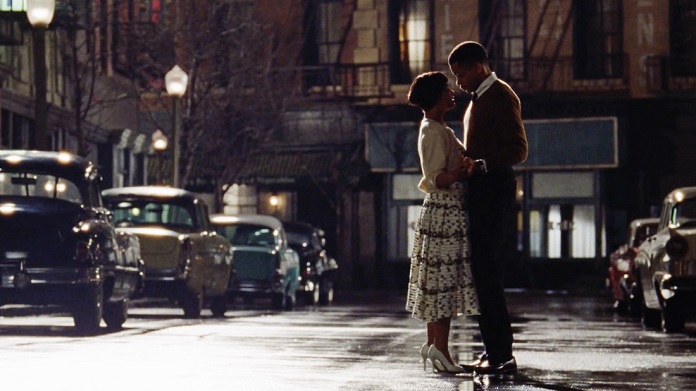
Sylvie’s Love
Studio: Amazon
Directed by Eugene Ashe
Dec 24, 2020
Web Exclusive
![]()
Tessa Thompson lights up the screen in Sylvie’s Love, a throwback to the classic melodramas of the 1950’s.
Writer/director Eugene Ashe sets this romance in the New York of the 50’s and 60’s, with a Technicolor palette to match and a glamorous outfit on Thompson in every scene. It’ll make excellent Holiday viewing, especially if you’re tired of all the movies with “timely” in the trailer.
The titular character, Sylvie (Thompson), is the quintessential mid-century heroine. She’s the daughter of a record store owner and a woman who can appreciate both Bill Haley and Sonny Rollins, while also being a fan of such TV shows as I Love Lucy. But she spends most of her time at the record store, alone, without anyone to talk to about the latest TV show or jazz album.
Enter Robert (Nnamdi Asomugha): a jazz fanatic in his own right, pouring his blood, sweat, and tears into a band he thinks will make it big. Robert and Sylvie meet at the record store after he asks for a job, and soon he’s swept her up in his whirlpool of lust and light. When she asks what his favorite song is on the latest Coltrane record, he replies, “You Don’t Know What Love Is,” a smooth answer if there ever was one.
But Sylvie, we soon discover, is engaged. Her fiance, a businessman who she met at cotillion, is away in Korea and she’s simply biding her time until he comes back. The introduction of Robert, thus, is more than a little disruptive for Sylvie, whose dilemma over whether she should follow her heart or follow her obligations, to her fiance and to her family, is at the center of this increasingly mellow drama.
While the story is formulaic at times, peppered with implausible coincidences (as many melodramas are), a somewhat silly but inoffensive twist, and a lackadaisical run-time, Sylvie’s Love works because of its cast, particularly Thompson, but also Tone Bell, John Magaro and Lance Reddick, who hits all the right notes as Sylvie’s cool and caring father.
The production design by Mayne Berke, especially in the Morocco Jazz Club, and cinematography by Declan Quinn make for a colorfully saturated fantasy of New York City that elevates the film. This is a New York that only exists in the movies—the trash, graffiti and belligerent locals are nowhere to be found. The New York Knicks might as well not exist.
Because Ashe takes melodrama seriously, he commits to its ethereal sensibilities. He doesn’t care about showing us New York as it was in 1959. Instead, he cloaks it in the rich palette of a Turner Movie Classic, offering a Manhattan lined with shiny cars and shimmering lamp posts, beautiful faces and rain-slicked streets. It’s the Manhattan of the movies, of Doris Day and Gene Kelley and Katherine Hepburn, and now Tessa Thompson. That she hangs with the best of them is a testament to her singular talent.
Author rating: 6.5/10
Average reader rating: 4/10
Current Issue

Issue #72
Apr 19, 2024 Issue #72 - The ‘90s Issue with The Cardigans and Thurston Moore
Most Recent
- 10 Best Songs of the Week: Nilüfer Yanya, Linn Koch-Emmery, Fat Dog, Crumb, St. Vincent, and More (News) —
- Fat Dog Announce New Album and Tour, Share Video for New Song “Running” (News) —
- The Obsessed, Howling Giant @ Brooklyn Meadows, NYC, April 12, 2024 (Review) —
- Premiere: Slow Joy Releases New Single and Video for “King Cowboy” (News) —
- Premiere: Mackenzie Shrieve Shares New Single “Didn’t I Tell Ya” Feat. Jane Bruce (News) —

Comments
Submit your comment
There are no comments for this entry yet.